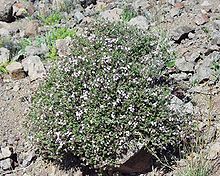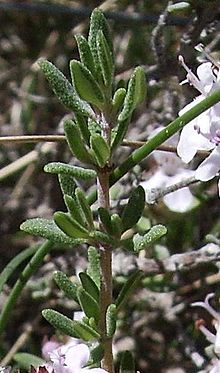- Thymus vulgaris
-
Thymus vulgaris Thyme, Thymus vulgaris Scientific classification Kingdom: Plantae (unranked): Angiosperms (unranked): Eudicots (unranked): Asterids Order: Lamiales Family: Lamiaceae Genus: Thymus Species: T. vulgaris Binomial name Thymus vulgaris
L.Thymus vulgaris or common thyme is a low growing herbaceous plant, sometimes becoming somewhat woody. It is native to southern Europe, where it is often cultivated as a culinary herb.
It typically grows as a sub-shrub, between 15 and 20 cm tall.
Contents
Cultivars
Nomenclature can be very confusing. [1] French, German and English varieties vary by leaf shape and colour and essential oils. [2] The many cultivars include 'Argenteus' (silver thyme). [3]
Uses
Thyme adds a distinctive aromatic flavoring to sauces, stews, stuffings, meats, poultry – almost anything from soup to salad. In medieval times, the plant symbolized courage, and to keep up their spirits, knights departing for the Crusades received scarves embroidered with a sprig of thyme from their ladies. There was a popular belief, too, that a leaf tea prevented nightmares, while another held that tea made of thyme and other herbs enabled one to see nymphs and fairies. Herbalists of the Middle Ages regarded thyme as a stimulant and antispasmodic, and recommended sleeping on thyme and inhaling it as a remedy for melancholy and epilepsy.
In 1725, a German apothecary discovered that the plant's essential oil contains a powerful disinfectant called thymol that is effective against bacteria and fungi.[citation needed] Thymol also acts as a expectorant, loosening phlegm in the respiratory tract so it can be coughed up. Later herbalists listed thyme for these uses and as remedy for numerous other complaints, including diarrhoea and fever. They prescribed the oil externally as an antiseptic for fungal infections such as athlete's foot.
Toxicology
The United States Environmental Protection Agency is not aware of any adverse effects of thymol to humans or the environment when it is used in a manner prescribed by product labeling.[4]
Aroma profiles
Notes and references
- ^ Totally Thyme
- ^ Herbs 2000: Thymus vulgaris
- ^ Thymus argenteus
- ^ "Reregistration Eligibility Decision Facts: Thymol" (PDF). Environmental Protection Agency. http://www.epa.gov/oppsrrd1/REDs/factsheets/3143fact.pdf. Retrieved 2010-12-03.
- ^ Goodner, K.L. et al.; Mahattanatawee, K; Plotto, A; Sotomayor, J; Jordan, M (2006). "Aromatic profiles of Thymus hyemalis and Spanish T. vulgaris essential oils by GC–MS/GC–O". Industrial Crops and Products 24 (3): 264–268. doi:10.1016/j.indcrop.2006.06.006.
- ^ Lee, Seung-Joo et al.; Umano, K; Shibamoto, T; Lee, K (2005). "Identification of volatile components in basil (Ocimum basilicum L.) and thyme leaves (Thymus vulgaris L.) and their antioxidant properties". Food Chemistry 91 (1): 131–137. doi:10.1016/j.foodchem.2004.05.056.
Other sources
- L. H. Bailey; Manual of Cultivated Plants.
- M. Easter; International Thymus Register and Checklist.
See also
Categories:- Thymus (genus)
- Flora of the Mediterranean
- Flora of Europe
- Flora of Lebanon
- Herbs
- Medicinal plants
- Lamiaceae stubs
Wikimedia Foundation. 2010.


